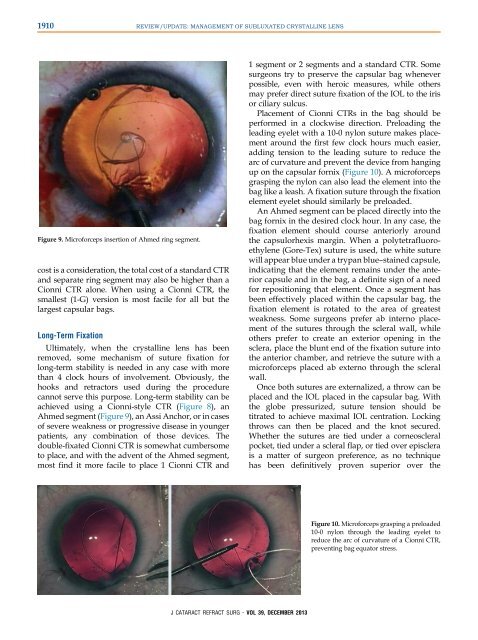Management of Subluxated Lens
Management of Subluxated Lens
Management of Subluxated Lens
You also want an ePaper? Increase the reach of your titles
YUMPU automatically turns print PDFs into web optimized ePapers that Google loves.
1910 REVIEW/UPDATE: MANAGEMENT OF SUBLUXATED CRYSTALLINE LENS<br />
Figure 9. Micr<strong>of</strong>orceps insertion <strong>of</strong> Ahmed ring segment.<br />
cost is a consideration, the total cost <strong>of</strong> a standard CTR<br />
and separate ring segment may also be higher than a<br />
Cionni CTR alone. When using a Cionni CTR, the<br />
smallest (1-G) version is most facile for all but the<br />
largest capsular bags.<br />
Long-Term Fixation<br />
Ultimately, when the crystalline lens has been<br />
removed, some mechanism <strong>of</strong> suture fixation for<br />
long-term stability is needed in any case with more<br />
than 4 clock hours <strong>of</strong> involvement. Obviously, the<br />
hooks and retractors used during the procedure<br />
cannot serve this purpose. Long-term stability can be<br />
achieved using a Cionni-style CTR (Figure 8), an<br />
Ahmed segment (Figure 9), an Assi Anchor, or in cases<br />
<strong>of</strong> severe weakness or progressive disease in younger<br />
patients, any combination <strong>of</strong> those devices. The<br />
double-fixated Cionni CTR is somewhat cumbersome<br />
to place, and with the advent <strong>of</strong> the Ahmed segment,<br />
most find it more facile to place 1 Cionni CTR and<br />
1 segment or 2 segments and a standard CTR. Some<br />
surgeons try to preserve the capsular bag whenever<br />
possible, even with heroic measures, while others<br />
may prefer direct suture fixation <strong>of</strong> the IOL to the iris<br />
or ciliary sulcus.<br />
Placement <strong>of</strong> Cionni CTRs in the bag should be<br />
performed in a clockwise direction. Preloading the<br />
leading eyelet with a 10-0 nylon suture makes placement<br />
around the first few clock hours much easier,<br />
adding tension to the leading suture to reduce the<br />
arc <strong>of</strong> curvature and prevent the device from hanging<br />
up on the capsular fornix (Figure 10). A micr<strong>of</strong>orceps<br />
grasping the nylon can also lead the element into the<br />
bag like a leash. A fixation suture through the fixation<br />
element eyelet should similarly be preloaded.<br />
An Ahmed segment can be placed directly into the<br />
bag fornix in the desired clock hour. In any case, the<br />
fixation element should course anteriorly around<br />
the capsulorhexis margin. When a polytetrafluoroethylene<br />
(Gore-Tex) suture is used, the white suture<br />
will appear blue under a trypan blue–stained capsule,<br />
indicating that the element remains under the anterior<br />
capsule and in the bag, a definite sign <strong>of</strong> a need<br />
for repositioning that element. Once a segment has<br />
been effectively placed within the capsular bag, the<br />
fixation element is rotated to the area <strong>of</strong> greatest<br />
weakness. Some surgeons prefer ab interno placement<br />
<strong>of</strong> the sutures through the scleral wall, while<br />
others prefer to create an exterior opening in the<br />
sclera, place the blunt end <strong>of</strong> the fixation suture into<br />
theanteriorchamber,andretrievethesuturewitha<br />
micr<strong>of</strong>orceps placed ab externo through the scleral<br />
wall.<br />
Once both sutures are externalized, a throw can be<br />
placed and the IOL placed in the capsular bag. With<br />
the globe pressurized, suture tension should be<br />
titrated to achieve maximal IOL centration. Locking<br />
throws can then be placed and the knot secured.<br />
Whether the sutures are tied under a corneoscleral<br />
pocket, tied under a scleral flap, or tied over episclera<br />
is a matter <strong>of</strong> surgeon preference, as no technique<br />
has been definitively proven superior over the<br />
Figure 10. Micr<strong>of</strong>orceps grasping a preloaded<br />
10-0 nylon through the leading eyelet to<br />
reduce the arc <strong>of</strong> curvature <strong>of</strong> a Cionni CTR,<br />
preventing bag equator stress.<br />
J CATARACT REFRACT SURG - VOL 39, DECEMBER 2013


